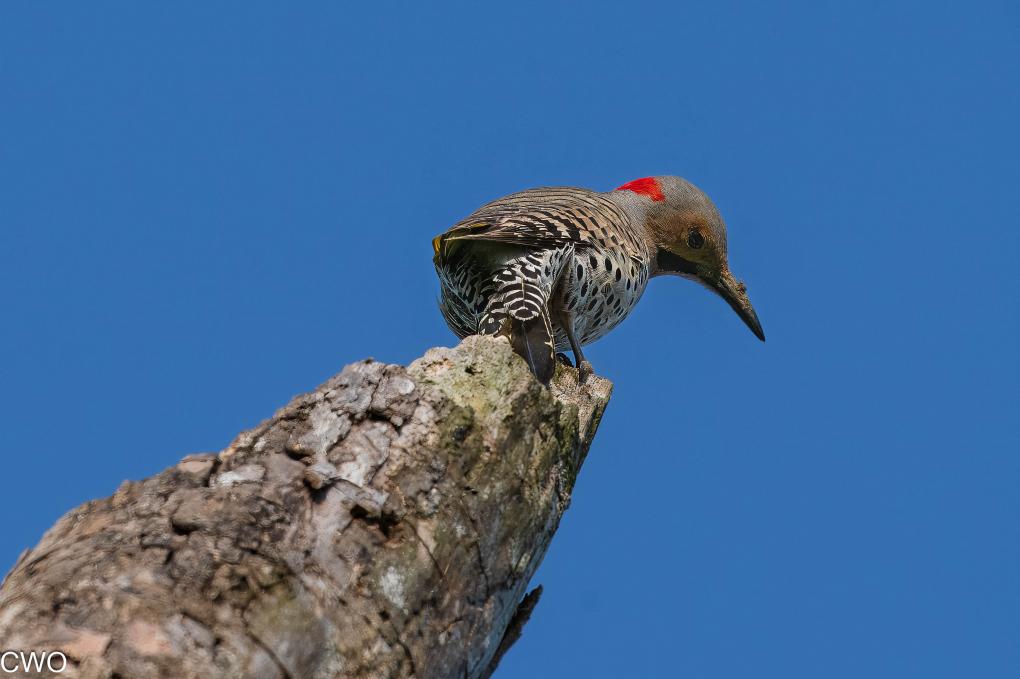The Cornell Lab Bird Academy › Discussion Groups › The Wonderful World of Woodpeckers › How Woodpeckers Rule the World of Wood
-
Bird AcademyBird AcademyWoodpeckers are amazing woodworkers thanks to the many anatomical features and behaviors that help them rule the world of wood. What are your favorite woodpecker adaptations?You must be enrolled in the course to reply to this topic.
-
I love hearing the different rhythms and sounds they make when they’re pounding on the trees in our yard. Interesting to learn that there are four reasons they peck: communicating, exploring the tree, digging out insects, and excavating a nest. The pileated woodpecker makes a huge holes in our snags. The red- breasted sapsucker makes a tidy row of small holes.
-
The tongue that adapts to make it advantageous to get food.
-
The tongue that wraps around the back of the skull. I've dropped this fact into conversations with non-birders from time to time. They always have to Google it to see if I'm telling the truth.
-
THE SOUNDS THEY MAKE WHEN THEY ARE TAPPING AND DRILLING
-
Their ability to drill and drum and not hurt their heads.
-
Their long ,barbed tongues are amazing! I didn't know this woodpecker fact before starting the course.
-
The stiff tail feathers, which create stability.
-
I was unaware of the unique tongue features. Despite having photographed and watched Woodpeckers the tongue are seldom seen.
-


-
The tongue by far is the most amazing adaptation. Just from the length alone and how it curls back into the head is unexplainable, however, necessary when you think of what it does and what it is used for. Also, the barbs and brush like structures at the end of the tongue were rather exciting to learn about.
-
The most fascinating adaptation to me is the woodpecker's tongue. I knew woodpeckers had longer than average tongues, but didn't realize how long. Also, the barbs or brushes at the tip of the tongue, and the fact that the tips can regrow when worn out was new to me. We have seven species of woodpeckers living in the area surrounding our home, so we see and enjoy a lot of woodpecker activity, but these close-up videos and explanations of the woodpecker's adaptations are making me appreciate our woodpecker neighbors more than ever.
-
I was amased at the length of the tongue and the different structures of the tongue to help the get food! I always thought they did most of the food gathering with the pounding of the bill but see now how they all work together!
-
The different structures at the end of their tongues is something I wasn’t aware of, and that’s quite fascinating. I loved seeing the way the harpoon-type structure can snag larvae to drag them out.
-
That incredible tongue.
-
Woodpeckers are truly amazing birds. Their bills can chisel away live wood, their super long tongues can penetrate deep inside crevices and snag larvae with their specialized tips. Woodpeckers are both colourful and matched incredibly to the task.
-
I am impressed by those tongues!
-
I was amazed to learn about the stability provided to the woodpecker by it’s zygodactyl feet and rigid tail. I will definitely look differently at a woodpecker the next time I see one!
-
Great observation. I too will be looking for this when I watch the woodpeckers work.
-
Those are the adaptations that I find most interesting too. I just love watching woodpeckers moving in the trees.
-
-
How the long tongue can wrap around the skull
-
All of it! Their tripod tail, toes that can extend, reach and grip like monkeys, amazing bill and fishing tongue. AS a bonus, they have pleasing vertical silhouettes and art-worthy plumage.
-
The different tongue tip structures!
-
My favorite woodpecker adaptations are their zygodactyl feet and their long tongues. It was interesting to learn that the woodpecker will move one toe sideways to give it more security while pecking on a tree. Their long tongues are impressive, but the fact that they have added adaptations, like the addition of hair-like features, barbs, or brushes that help the woodpeckers grasp their prey is a marvel!
-
Those tongues are facsinating!
-
I like the tail on the pileated woodpecker who visits my suet feeders. I enjoy watching him plan his attack on his feeder of choice, using his tail for support.
-
I didn't know about the fact that woodpeckers use their tail feathers like a kickstand to stabilize them on a tree, and I'm amazed that their tongues are so long and barbed!
Read More:

